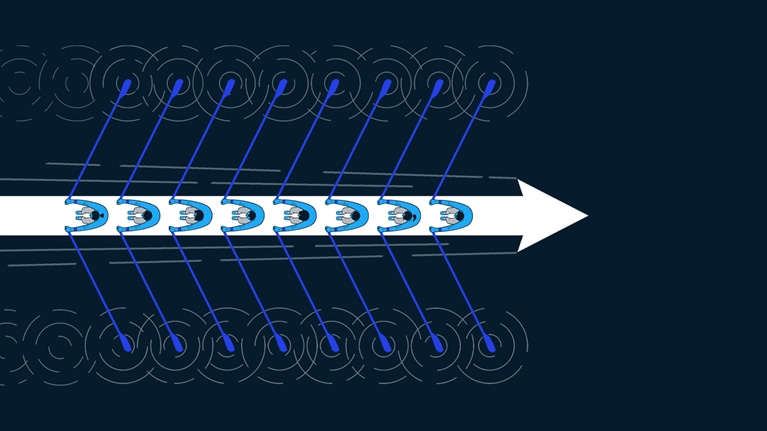In this two-part series, we will discuss the past decade of disruption, show why 2020 made the strategies and tactics of the past ineffective for our future, and outline the immense opportunities now available to Australian business leaders who can reinvent, reimagine, and respond.
Each generation of business leaders likely believes the forces they face are more profound than those of previous generations. This time, they may be right. Even prior to 2020, multiple trends were complicating the competitive landscape: heightened geopolitical tension, an increased focus on sustainable and responsible business, radical changes in consumer buying behaviour and expectations, and faster technological change. The COVID-19 pandemic has been an accelerant and shock to the system. Having survived the upheaval, Australian executives are now looking to the next decade with an eye toward growth. However, it won’t be as easy as flipping a light switch.
In many respects, 2020 was an inflection point. Over the previous decade, the Australian economy had hummed along, and companies achieved stable growth. Now that the landscape has completely shifted, they can’t simply return to their established strategies. Companies that hadn’t invested in innovation as a core function prior to the pandemic are already struggling to meet new demands by clients and employees.
Charting a path toward renewed growth will require immediate reinvention, not incrementalism. Executives must first understand all the ways in which 2020 irrevocably changed the game, revisit how their company got to its current state, and courageously pursue the necessary moves. Executives who get it right will benefit for years to come: our research has found companies that successfully emerge from a crisis can continue on a growth trajectory for the following decade. The time to act is now.
2020—The great acceleration
The past year has been one of not only great disruption but also great acceleration. Like an earthquake that releases millions of years of pressure in a matter of seconds, COVID-19 forced companies to implement years of change in a matter of months.
Consumer behaviour has been reset
Our consumer research has shown that more than 50 percent of Australians have adopted new shopping behaviours, and 30 percent have tried new brands. Depending on the segment, digital adoption has increased by 30 to 50 percent compared with before the crisis; 60 percent of baby boomers are now regularly using these channels. Australians report a consistently high intent to continue or increase their use of digital experiences. For example, grocery delivery has risen 25 percent, with 50 percent of new users reporting that they intend to continue using this service.
Employee experience has been transformed
Many companies are offering unprecedented levels of flexibility. In November 2008, only about 1 percent of Australian employees worked primarily from home. By 2019, about one-third of the working population was regularly working from home; in May 2020, that figure was around half.
The social contract has been disrupted
The relationship between consumers and producers, companies and investors, and public and private has changed. We have seen an interplay of public and private sectors and the involvement by governments in a way not seen outside wartime. Responses such as relaxed capital expectations for banks due to COVID-19 and JobKeeper and JobSeeker payments have opened the aperture of government intervention, which may not close quickly.
Social responsibility is also becoming a driver of demand. The rise of a more ethical consumer is not new—this trend has been more prevalent for younger segments compared with their older peers—but now more than 20 percent of every demographic segment we surveyed reports COVID-19 made them more likely to purchase from companies that sold sustainable and eco-friendly products.1
The concept of what is ‘possible’ has changed
Shifts that have previously taken organisations months or years are now taking days or weeks. A grocery retailer doubled its online order volume in a single month through rapid redeployment of people and innovative offerings. An Australian brewer increased and switched production from bulk B2B to small package sizes in just one week. Gin distillers retooled their operations to be able to rapidly produce hand sanitizer to meet the demand generated by the pandemic. Suppliers with 3-D printing capability were able to shift to production of personal protective equipment. And temporarily closed restaurants innovated by packaging cocktails and high-end food for home-dining experiences.
Our analysis found the top-line market recovery since March 2020 has masked extreme variations—not just across sectors, but also within them. The markets already seem to be rewarding companies that have experienced the greatest deal of transformation or self-disruption.
Exhibit 1 shows the total returns to shareholders (TRS) of the 200 largest companies in Australia. The differences in the average move by sector are instructive. Tech and media, retail, energy, and healthcare have added value. More highly capitalised, older-economy industries have lost significant market capitalisation. We have even seen significant variance within sectors. While some, such as transport and infrastructure, have been uniformly hit, in consumer, tech, and media, the range of performance is significant.

Uneven distribution of performance is also reflected globally. From January 2020 to November 2020, the 20 largest global companies added 58 percent in market capitalisation, but this tide has not lifted all boats evenly. For instance, in tech and media, the 80th percentile included companies whose market cap performance ranged from –40 percent to +70 percent.
The predictability that enables incumbents to derive so much strength has been existentially challenged; disruptions that seemed optional and peripheral are now urgent and central. This pattern highlights why companies need to make bold moves to their business model to respond to an uncertain demand environment.
The 2010s: A nation growing or coasting?
Over the past decade, Australia enjoyed an enviable period of economic growth. Going into the crisis, shareholder returns ranked fourth among the largest ten economies by GDP. But under the surface, Australian companies in aggregate appear relatively underprepared for the next decade as gauged by investment and reinvention.
The key measure we use to assess these strategies is economic profit: the returns a company generates after the cost of capital. By this critical yardstick, the economic profit generated by Australia’s 200 largest companies has dropped 71 percent over the past decade. In contrast, it grew 14 percent for the 200 largest companies in the United States.
The source of falling economic profit can be boiled down to a slower rate of reinvention, which is best illustrated by looking at the underlying performance and investment track record of Australian companies. While they grew in line with their US peers from 2009 to 2019, at a CAGR of approximately 5 percent, their returns on invested capital both dropped (two percentage points versus one percentage point for US companies) and ended up lower (9 percent versus 10 percent). Over the decade, margins grew by two percentage points for US companies but remained flat for Australian companies (see sidebar, “High growth and high returns have been mutually exclusive”).
As a result, Australia’s top 200 has been relatively static across companies and sectors. And established companies have proved less mobile than those in other markets. A look at McKinsey’s global power curve2 shows Australia’s top companies skew strongly to the middle of the pack. Nearly 65 percent fall in the three middle quintiles—neither terrible nor great. More notable is that fewer Australian companies, just 6 percent, have successfully moved from the middle to the top (Exhibit 2).

The risk to incumbents is that in a period of disruption, the middle is no safe place to be. Incumbents looking to thrive in the coming decade will need to make shifts in their business and operating models, and the level of change required will in fact be greater in Australia than in other markets.
I am asking myself ... how do we use the disruption and pain brought about by COVID-19 for good in the future? How do we use it to accelerate the transformation of our businesses? How do we use it to bring new experiences to our customers?
The year of the pivot
The year 2021 will be vital for Australian companies. Our research on previous crises has shown that the way in which companies emerge from a downturn sets the tone for their performance over the next decade. Since the global financial crisis in 2008, resilient companies—defined as those in the top quartile by TRS during the downturn and recovery—consistently outperformed peers for a decade (Exhibit 3). While companies may have been tempted to set their sights solely on immediate survival in the early part of the pandemic, the impact of such strategic focus stretches well into the medium to long term.

Many Australian companies have put big moves on hold over the past year—essentially a strategic lockdown. M&A volumes fell 42 percent between 2019 and 2020, and average capital expenditures fell by 15 percent (Exhibit 4). Survival budgeting may have seemed prudent during the early stages of the pandemic, but this strategic lockdown quickly crosses the threshold of diminishing marginal returns. In our view, this approach needs to shift quickly because reinvention coming out of a crisis requires bold moves (including the reallocation of capital).

We see three reasons why 2021 offers a unique window for bold moves. First, customers and stakeholders are more open to change. Last year was a shock to not only normality but also rigidity. Whether in boardrooms, shareholder meetings, or supermarket aisles, your stakeholders and customers enter 2021 with fresh outlooks on how “normal” the next phase can be. Companies can use the great shifts of 2020 to reemphasize the change and transformation their products and services need for 2021 and beyond.
Second, successfully managing a crisis can boost institutional trust, enabling companies to tap a rare combination of social cohesion, social capital, and social inquisitiveness. This year offers a generational opportunity for proactive companies to mobilise a broader set of stakeholders to push the organisation to the next level.
Companies must define their purpose with authenticity and align it with clear actions. An authentic purpose can cut through the usual malaise of decision making. In 2020, the purpose in transformation was clear, and that drive was internalised—survive! We believe that organisations can redefine their purpose with equal clarity to enable more structural and positive change.
Third, operational transformation is no longer theoretical; it’s lived experience. As lockdowns rolled around Australia, the single-focus, “fail fast, fix early” approach, with delegated problem solving and an agile mindset, suddenly played out in teams, businesses, and homes everywhere. The past year briefly made Australia a nation of startups—and it has worked.
We did so many things during COVID-19 that I never thought possible, but we are going back to old habits already. How do I move to capture this quickly?
Indeed, 2020 both accelerated disruption trends and shattered the risk aversion that had caused some organisations to see transformation as a value-add rather than compulsory. Shifts that would otherwise have taken years happened in a matter of weeks. In a sense, prioritising transformation and embracing reinvention suddenly became a no-brainer.
Even between businesses, new levels of speed and agility emerged. Partnerships across private- and public-sector organisations sprang up quickly with little or no contractual negotiation. Excellent examples include the successful reskilling and redeployment between Qantas and Woolworths and the collaboration among banks, financial regulators, and government to keep credit in the economy.
Many companies that once looked outward for techniques such as agile or zero-based design can now observe them within their own walls.
With these experiences still fresh in businesses and communities, and with systemic challenges still present, Australia may be emerging from 2020 into the greatest reinvention opportunity in 50 years.
The decade that favors the brave
It’s a political axiom that the times create the leader. The context we have outlined for this decade—and the opportunity for bold, creative business leaders—is clear.
While taking a centrist approach can carry organisations through stable periods, it does not provide the agility to survive and prosper in periods of upheaval. More important, Australian companies can most benefit by adopting a different mentality to seize significant growth opportunities and exploit post-COVID-19 disruptions at scope, scale, and speed.
Companies and leaders should lean into this disruption and set ambitious targets for the reinvention of strategy, technology—such as digital, analytics, and core technology—and organisation. While pursuing these goals simultaneously will be challenging, large changes at once can also pay off tremendously.
In Part II of this series, we will unpack what leaders can do now to reinvent their organisations by looking at the bold moves required across strategy, operating model, and technology. We will show why we may not have the luxury of time, so companies should consider making these big moves in parallel. Finally, we will reveal the key success factors that can allow leaders to have confidence their organisations can deliver across multiple priorities simultaneously.
This is a two-part knowledge series on reinvention for Australian companies. Read the second part of this series at How Australian companies can reinvent themselves in 2021.



